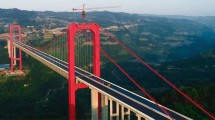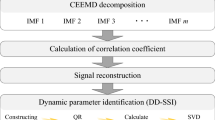Abstract
Internal and external factors impacted the safety of large-scale civil engineering structures after their construction. Thus, this study used the real-time kinematic global navigation satellite system (RTK-GNSS) technology to monitor a super-high-rise building and a long-span bridge in China. First, the effects of positioning errors and noise in the different environments were investigated. And this study revealed that the multipath-dominated background noise generated by water is not negligible. To suppress noise, the researchers next proposed a hybrid noise reduction algorithm that combined wavelet threshold (WT) and complete empirical mode decomposition with adaptive noise (CEEMDAN) based on autocorrelation function and cross-correlation coefficient. The results proved that the method applied can weaken noise and maintain adequate information. The noise reduction is the best compared with ensemble empirical mode decomposition (EEMD), CEEMDAN, and EEMD-Chebyshev. Finally, the direction of the main motion of the super-high-rise building is calculated. And the error between the first-order frequency and finite-element analysis is 0.189%, the maximum relative error for the third-order frequency is only 4.379%. The frequencies, damping ratios, and failure probabilities of the Fumin bridge are also obtained under different traffic loads. Furthermore, the intrinsic frequency inaccuracy measured by RTK-GNSS is less than that by the accelerometer in the same monitoring period.



























Similar content being viewed by others
References
Yi TH, Li HN, Gu M (2013) Wavelet based multi-step filtering method for bridge health monitoring using GPS and accelerometer. Smart Mater Struct 11(4):331–348. https://doi.org/10.12989/sss.2013.11.4.331
Kim K, Choi J, Chung J, Koo G, Bae IH, Sohn H (2018) Structural displacement estimation through multi-rate fusion of accelerometer and RTK-GPS displacement and velocity measurements. Measurement 130:223–235. https://doi.org/10.1016/j.measurement.2018.07.090
Yuan K, Zhu W (2021) Estimation of modal parameters of a beam under random excitation using a novel 3D continuously scanning laser Doppler vibrometer system and an extended demodulation method. Mech Syst Signal Proc 155:107606. https://doi.org/10.1016/j.ymssp.2021.107606
González-Aguilera D, Gómez-Lahoz J, Sánchez J (2008) A new approach for structural monitoring of large dams with a three-dimensional laser scanner. Sensors 8(9):5866–5883. https://doi.org/10.3390/s8095866
Weisbecker H, Cazzolato B, Wildy S, Marburg S, Codrington J, Kotousov A (2012) Surface strain measurements using a 3D scanning laser vibrometer. Exp Mech 52(7):805–815. https://doi.org/10.1007/s11340-011-9545-5
Schlögl M, Widhalm B, Avian M (2021) Comprehensive time-series analysis of bridge deformation using differential satellite radar interferometry based on Sentinel-1. ISPRS-J Photogramm Remote Sens 172:132–146. https://doi.org/10.1016/j.isprsjprs.2020.12.001
Granello G, Andisheh K, Palermo A, Waldin J (2018) Microwave radar interferometry as a cost-efficient method of monitoring the structural health of bridges in New Zealand. Struct Eng Int 28(4):518–525. https://doi.org/10.1080/10168664.2018.1461538
Zhang G, Guo G, Li L, Yu C (2018) Study on the dynamic properties of a suspended bridge using monocular digital photography to monitor the bridge dynamic deformation. J Civ Struct Health Monit 8(4):555–567. https://doi.org/10.1007/s13349-018-0293-4
Chen SE, Rice C, Boyle C, Hauser E (2011) Small-format aerial photography for highway-bridge monitoring. J Perform Constr Facil 25(2):105–112. https://doi.org/10.1061/(ASCE)CF.1943-5509.0000145
Yu J, Meng X, Yan B, Xu B, Fan Q, Xie Y (2020) Global Navigation Satellite System-based positioning technology for structural health monitoring: a review. Struct Control Health Monit 27(1):e2467. https://doi.org/10.1002/stc.2467
Shen N, Chen L, Liu J, Wang L, Tao T, Wu D, Chen R (2019) A review of global navigation satellite system (GNSS)-based dynamic monitoring technologies for structural health monitoring. Remote Sens 11(9):1001. https://doi.org/10.3390/rs11091001
Li H, Nie G, Chen D, Wu S, Wang K (2019) Constrained MLAMBDA method for multi-GNSS structural health monitoring. Sensors 19(20):4462. https://doi.org/10.3390/s19204462
Ogundipe O, Lee JK, Roberts GW (2014) Wavelet de-noising of GNSS based bridge health monitoring data. J Appl Geod 8(4):273–282. https://doi.org/10.1515/jag-2014-0011
Wang X, Zhao Q, Xi R, Li C (2021) Li G (2021) Review of bridge structural health monitoring based on GNSS: from displacement monitoring to dynamic characteristic identification. IEEE Access 9:80043–80085. https://doi.org/10.1109/ACCESS.2021.3083749
Beshr AAA, Zarzoura FH (2021) Using artificial neural networks for GNSS observations analysis and displacement prediction of suspension highway bridge. Innov Infrastruct Solut 6(2):109. https://doi.org/10.1007/s41062-021-00458-4
Zhang R, Gao C, Pan S, Shang R (2020) Fusion of GNSS and speedometer based on VMD and its application in bridge deformation monitoring. Sensors 20(3):694. https://doi.org/10.3390/s20030694
Li X, Huang G, Zhang Q, Zhao Q (2018) A new GPS/BDS tropospheric delay resolution approach for monitoring deformation in super high-rise buildings. GPS Solut 22(3):1–12. https://doi.org/10.1007/s10291-018-0752-8
Xiong C, Niu Y (2019) Investigation of the dynamic behavior of a super high-rise structure using RTK-GNSS technique. KSCE J Civ Eng 23(2):654–665. https://doi.org/10.1007/s12205-018-0238-9
Roberts GW, Brown CJ, Tang X, Meng X, Ogundip O (2014) A tale of five bridges; the use of GNSS for monitoring the deflections of bridges. J Appl Geod 8(4):241–264. https://doi.org/10.1515/jag-2014-0013
Xin J, Zhou J, Yang SX, Li X, Wang Y (2018) Bridge structure deformation prediction based on GNSS data using Kalman-ARIMA-GARCH model. Sensors 18(1):298. https://doi.org/10.3390/s18010298
Yu S, Guo F, Zhang X, Liu W, Li X, Wu R (2018) A new method for GNSS multipath mitigation with an adaptive frequency domain filter. Sensors 18(8):2514. https://doi.org/10.3390/s18082514
Souza EM, Negri TT (2017) First prospects in a new approach for structure monitoring from GPS multipath effect and wavelet spectrum. Adv Space Res 59(10):2536–2547. https://doi.org/10.1016/j.asr.2017.02.043
Boccia L, Amendola G, Gao S, Chen CC (2014) Quantitative evaluation of multipath rejection capabilities of GNSS antennas. GPS Solut 18(2):199–208. https://doi.org/10.1007/s10291-013-0321-0
Niu Y, Ye Y, Zhao W, Shu J (2021) Dynamic monitoring and data analysis of a long-span arch bridge based on high-rate GNSS-RTK measurement combining CF-CEEMD method. J Civ Struct Health Monit 11(1):35–48. https://doi.org/10.1007/s13349-020-00436-x
Xu A, Wu J, Zhao R (2014) Wavelet-transform-based damping identification of a super-tall building under strong wind loads. Wind Struct 19(4):353–370. https://doi.org/10.12989/was.2014.19.4.353
Yi J, Zhang JW, Li QS (2013) Dynamic characteristics and wind-induced responses of a super-tall building during typhoons. J Wind Eng Ind Aerodyn 121:116–130. https://doi.org/10.1016/j.jweia.2013.08.006
He XH, Hua XG, Chen ZQ, Huang FL (2011) EMD-based random decrement technique for modal parameter identification of an existing railway bridge. Eng Struct 33(4):1348–1356. https://doi.org/10.1016/j.engstruct.2011.01.012
Wu Z, Huang NE (2009) Ensemble empirical mode decomposition: a noise-assisted data analysis method. Adv Adapt Data Anal 1(1):1–41. https://doi.org/10.1142/S1793536909000047
Yeh JR, Shieh JS, Huang NE (2010) Complementary ensemble empirical mode decomposition: A novel noise enhanced data analysis method. Adv Adapt Data Anal 2(2):135–156. https://doi.org/10.1142/S1793536910000422
Wu B, Gao Y, Ma N, Chanwimalueang T, Yuan X, Liu J (2021) Fault diagnosis of bearing vibration signals based on a reconstruction algorithm with multiple side Information and CEEMDAN method. J Vibroeng 23(1):127–139. https://doi.org/10.21595/jve.2020.21586
Fan Q, Meng X, Nguyen DT, Xie Y, Yu J (2020) Predicting displacement of bridge based on CEEMDAN-KELM model using GNSS monitoring data. J Appl Geod 14(3):253–261. https://doi.org/10.1515/jag-2019-0057
Mousavi AA, Zhang C, Masri SF, Gholipour G (2020) Structural damage localization and quantification based on a CEEMDAN Hilbert transform neural network approach: a model steel truss bridge case study. Sensors 20(5):1271. https://doi.org/10.3390/s20051271
Ye X, Sun Z, Chen B (2019) Research on modal parameters identification of bridge structure based on adaptive signal de-noising method. Cluster Comput 22(6):14377–14387. https://doi.org/10.1007/s10586-018-2301-1
Ni Y, Lu X, Lu W (2017) Operational modal analysis of a high-rise multi-function building with dampers by a Bayesian approach. Mech Syst Signal Proc 86:286–307. https://doi.org/10.1016/j.ymssp.2016.10.009
Naderpour H (2016) Fakharian P (2016) A synthesis of peak picking method and wavelet packet transform for structural modal identification. KSCE J Civ Eng 20(7):2859–2867. https://doi.org/10.1007/s12205-016-0523-4
Wu WH, Wang SW, Chen CC, Lai G (2019) Modal parameter identification for closely spaced modes of civil structures based on an upgraded stochastic subspace methodology. Struct Infrastruct Eng 15(3):296–313. https://doi.org/10.1080/15732479.2018.1547770
Kim S, Kim HK, Hwang YC (2018) Enhanced damping estimation for cable-stayed bridges based on operational monitoring data. Struct Eng Int 28(3):308–317. https://doi.org/10.1080/10168664.2018.1462132
Feng ZQ, Zhao B, Hua XG, Chen ZQ (2019) Enhanced EMD-RDT method for output-only ambient modal identification of structures. J Aerosp Eng 32(4):04019046. https://doi.org/10.1061/(ASCE)AS.1943-5525.0001034
Zhou W, Chelidze D (2008) Generalized eigenvalue decomposition in time domain modal parameter identification. J Vib Acoust-Trans ASME 130(1):011001. https://doi.org/10.1115/1.2775509
El Bouny L, Khalil M, Adib A (2019) ECG signal filtering based on CEEMDAN with hybrid interval thresholding and higher order statistics to select relevant modes. Multimed Tools Appl 78(10):13067–13089. https://doi.org/10.1007/s11042-018-6143-x
Ruiz-Aguilar JJ, Turias I, González-Enrique J, Urda D, Elizondo D (2021) A permutation entropy-based EMD–ANN forecasting ensemble approach for wind speed prediction. Neural Comput Appl 33(7):2369–2391. https://doi.org/10.1007/s00521-020-05141-w
Sun Z, Xi X, Yuan C, Hua YY (2020) Surface electromyography signal denoising via EEMD and improved wavelet thresholds. Math Biosci Eng 17(6):6945–6962. https://doi.org/10.3934/mbe.202035
Xiong CB, Niu YB, Li Z (2018) An investigation of the dynamic characteristics of super high-rise buildings using real-time kinematic–global navigation satellite system technology. Adv Struct Eng 21(5):783–792. https://doi.org/10.1177/1369433217732497
Hao W, Yang Q (2021) Applicability of random decrement technique in extracting aerodynamic damping of crosswind-excited tall buildings. J Build Eng 38:102248. https://doi.org/10.1016/j.jobe.2021.102248
Ku CJ, Cermak JE, Chou LS (2007) Random decrement based method for modal parameter identification of a dynamic system using acceleration responses. J Wind Eng Ind Aerodyn 95(6):389–410. https://doi.org/10.1016/j.jweia.2006.08.004
Siringoringo DM, Fujino Y (2008) System identification of suspension bridge from ambient vibration response. Eng Struct 30(2):462–477. https://doi.org/10.1016/j.engstruct.2007.03.004
Acknowledgements
This work was supported by the National Natural Science Foundation of China (No. 61971037). We sincerely thank Tianjin University and Tianjin Surveying and Hydrography Co., Ltd for providing the experimental equipment.
Author information
Authors and Affiliations
Contributions
Conceptualization: CX, MW; methodology: MW; formal analysis and investigation: MW; writing—original draft preparation: MW; writing—review and editing: WC; supervision: CX.
Corresponding author
Ethics declarations
Conflicts of interest
The authors declare that there is no conflict of interest.
Additional information
Publisher's Note
Springer Nature remains neutral with regard to jurisdictional claims in published maps and institutional affiliations.
Rights and permissions
About this article
Cite this article
Xiong, C., Wang, M. & Chen, W. Data analysis and dynamic characteristic investigation of large-scale civil structures monitored by RTK-GNSS based on a hybrid filtering algorithm. J Civil Struct Health Monit 12, 857–874 (2022). https://doi.org/10.1007/s13349-022-00580-6
Received:
Revised:
Accepted:
Published:
Issue Date:
DOI: https://doi.org/10.1007/s13349-022-00580-6




